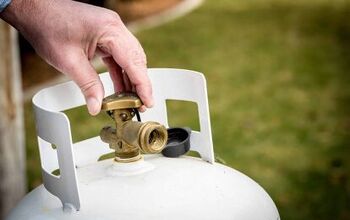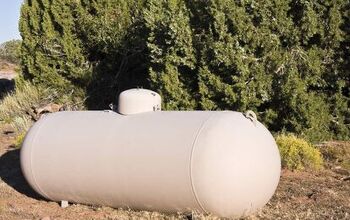How To Tell How Much Propane Is Left In A 100 Lb. Tank

Whether you are using propane for your BBQ cookout or heating your home, it can be challenging to know how much propane is left in your tank. Especially because most propane tanks do not come with a gauge, you may never know how to tell how much fuel is remaining. Suddenly running out of propane is a drag. Especially if you are using a 100 lb tank, you definitely want to know how much fuel you have remaining. Luckily there are a few ways to check the level of propane anytime you need.
The easiest way to tell how much propane is left in a 100 lb tank is to purchase a propane gauge simply. If this is not possible, then you have a few other options to do so without one. Alternatively, you can check the level with hot water or by testing the weight of the propane tank.
In this article, we will explain several ways you can measure how much propane is left in your 100-pound propane tank. If you don’t have a gauge, that’s okay. We have several alternative methods for you to try as well.
Do You Need a Heating and Cooling Contractor?
Get free, zero-commitment quotes from pro contractors near you.

What Is Propane?
Propane is also known as petroleum gas or LPG. It is compressed and stored as a liquid, but propane is known as propane autogas when used as vehicle fuel. This gas is nontoxic, colorless, and odorless. Don’t remember propane being odorless? Marketed propane does have an odor, but the scent you may remember is actually added in.
This is added as a safety precaution so that if the gas happens to leak, it can be detected. Propane is usually used for water or space heating but is also used for cooking and fuel. When used as a fuel, it is typically used for forklifts, farm irrigation engines, fleet vehicles, and buses, but many new developments for propane as fuel are on the way.
It is very harmful when a propane leak occurs indoors. LPG will cause you to suffocate, similar to carbon monoxide. At high concentrations, propane can have the same effect as carbon monoxide suffocation.
Using Hot Water
This method is extremely simple and should take no more than a minute or two. In order to practice this method, you can begin with three simple steps.
- You will first need to fill a cup or a small bucket with hot water.
- Next, pour the hot water down the sides of your tank.
- Finally, run your hand down the side and feel for where there is a cool spot. This is your level of propane.
This occurs because the liquid propane inside the tank absorbs the heat from the water. This makes the metal wall cool feeling, and the tank above that line will feel warm.
Although this is not a completely accurate method of finding out how much propane is in your tank, it can give you a pretty good approximate. This method will not be helpful if you have a very small amount of propane left in your tank, but it can let you know if you need to fill up or not.
Test Its Weight
Depending on how long you have been using propane and propane products, you may be able to test it based on its weight. If you roughly know how heavy your tank should feel like full, then this will be easier. You can also simply use a scale for an exact measurement.
First, you should confirm that your propane tank is, in fact, 100 lbs. This is important because when weighing it, you will find your answer for any weight over 100 lbs. You can confirm this by looking at the numbers stamped on the handle. Typically the water capacity (WC) and the tank’s weight while empty (TW) will be visible.
If you are using a 100 lb propane tank, it will most likely be able to hold a capacity of around 118 lbs of propane. This means if you weigh your tank and it is 155 lbs, it means that you have about half a tank of propane left.
According To Cook Time
Depending on what you are using your propane tank for, you will be able to understand how long you can use it for. For example, if you are using a grill, one gallon of propane produces approximately 92,000 BTUs.
If you divide this number by the BTUs per hour that you use to work, then you will have the number of hours needed for you to use one gallon of propane at the highest setting. In order to find the BTUs per hour of your grill, you can specifically look up this rating.
Next, you should multiply the number of hours by the number of gallons in the tank. If you are using a 100 lb tank, then you will be able to hold 23.5 gallons of propane. The amount of use will vary depending on your grill and BTUs per hour.
This method is not completely helpful if you have not been practicing this method since a full tank, but it can be helpful if you start with a brand new tank. This method can also be combined with another method in order to get a better overall picture.
Buy A Gauge
The easiest method to know how much propane is left in your tank is to simply purchase a propane gauge. These gauges are easy to find at any hardware store or online and come in many different forms.
- Inline pressure gauges: These install between the gas line from the grill and the cut-off valve on the tank. They work with pressure and can give you a read, letting you know if the tank is low, empty, or completely full. Although they do not give you a specific number, it is definitely easier than weighing your tank.
- Analog propane scales: Working similar to a luggage scale, these gauges are tared for your tank’s weight and allow you to weight quickly. Simply slip the hook through the handle of the tank, then pick up your tank and read the gas level. This is a simpler method of weighing your tank.
- Digital propane tank scales: These gauges constantly weight the tank. They also provide you with a readout that will show you the cook time and gas fill percentage.
These gauges and scales range anywhere from $10 to $70 but are the absolute easiest and quickest method to finding out how much gas is in your propane tank.
How Do You Read A Propane Gauge?
You may notice after your propane tank has been filled, the gauge will read ‘80%’. This is because while propane is a gas, it’s in liquid form when it’s inside of the container. When the liquid turns into gas, it creates more volume, which means that you have 100% gas propane. So, if it only reads 80% after having it filled, don’t worry.
Therefore, while you have a 100-pound tank, you will never have 100 full pounds of propane in it since the liquid is a lot more dense than the gas. When your tank reads 10% is when you will need to get it refilled.
Can I Top Off My Tank?
It’s almost a better idea to top your tank off as you use the propane instead of waiting until it’s completely empty to do so. For some reason, after the tank is half empty, the propane gets used up a lot quicker. Instead, you can top it off to keep your propane use efficient.
Additionally, this will solve the issue of possibly running out. You won’t have any more guesswork as far as how much propane is left in the tank and whether or not you should call for a refill yet.
Related Questions
Where can I purchase a propane tank gauge?
Most hardware stores will host propane tank gauges, but you can typically find them on Amazon, or any online retailer. These should not cost a fortune, but a cheaper scale may break more easily.
Is it easy to measure propane by using hot water?
Although using the hot water method is a simple method, it may not be the best method. This is because it is not always completely accurate compared to using a gauge. If the hot water method is the only method you can use then it is fine to do so. Be aware that you may have trouble with this method if you have very low levels of propane in your tank,
Is propane toxic?
Yes, propane is quite toxic. If you smell propane you should attempt to find the leak immediately and go to open air. Do not use propane indoors.
Do You Need a Heating and Cooling Contractor?
Get free, zero-commitment quotes from pro contractors near you.

Wrapping It Up
Having a 100-pound propane tank has its advantages and disadvantages. One of those disadvantages is figuring out exactly how much propane is left in the tank. You can do this with a gauge, but also by checking it with hot water. Also, when you call your delivery service, you can ask them to check the levels for you as well. It wouldn’t hurt to ask them how long until you should start paying attention to the amount that’s in your tank.

Real estate agent and copywriter, originally from California. Chloe brings her real estate expertise into her writing to create effective and helpful home guides for you! When not writing or selling homes, she spends her time as a digital nomad traveling the world.
More by Chloe Meltzer














![How Much Weight Can a 4×4 Support Horizontally? [It Depends!]](https://cdn-fastly.upgradedhome.com/media/2023/07/31/9070333/how-much-weight-can-a-44-support-horizontally-it-depends.jpg?size=350x220)












